Tribological Properties and Lubrication Mechanisms of Water-Based Nanolubricants Containing TiO2 Nanoparticles during Micro Rolling of Titanium Foils
Abstract
:1. Introduction
2. Experimental Procedures
2.1. As-Received Material
2.2. Preparation of Nanolubricants
2.3. Micro Rolling Tests
2.4. Characterization and Analytical Approaches
3. Results and Discussion
3.1. Rolling Force and Surface Roughness
3.2. Surface Profile and 3D Morphologies
3.3. SEM-EDS Analysis
3.4. Lubrication Mechanisms
4. Conclusions
Summary
- A nano-TiO2 additive lubricant was developed and applied to micro rolling to enhance the surface quality of rolled titanium foils. Nano-TiO2 additive lubricants exhibited improved lubrication performance during micro rolling compared to the traditional O/W lubricants, confirming the superiority of nanolubricants compared to traditional O/W lubricants during lubrication.
- An optimal concentration of 3.0 wt.% nano-TiO2 additive lubricants was found for water-based nanolubricants, which agrees well with expectation. The application of prepared lubricant contributed to a remarkable reduction in the surface roughness of rolled titanium foils (~21.8%), which is mainly attributed to the synergism of the polishing and the mending effects of the nanoparticles.
- During micro rolling, the dense tribo-film and spherical nanoparticles isolates the working roll from direct contact with the titanium foils, which confirms the lubrication mechanism of nanolubricants. As a result, the TiO2 nanoparticles at the roll-strip contact interface inhibit the generation of cracks of titanium foils, enhancing the surface quality of rolled products.
Author Contributions
Funding
Institutional Review Board Statement
Informed Consent Statement
Data Availability Statement
Conflicts of Interest
References
- Kaplan, M.A.; Ivannikov, A.Y.; Konushkin, S.V.; Nasakina, E.O.; Baikin, A.S.; Kartabaeva, B.B.; Gorbenko, A.D.; Kolmakov, A.G.; Sevostyanov, M.A. Study of the Structure, Mechanical Characteristics, and Antibacterial Properties of Corrosion-Resistant Steel Alloyed with Silver and Titanium. Dokl. Chem. 2022, 502, 37–44. [Google Scholar] [CrossRef]
- Hasan, M.; Zhao, J.; Jiang, Z. Micromanufacturing of composite materials: A review. Int. J. Extrem. Manuf. 2019, 1, 012004. [Google Scholar] [CrossRef]
- Yahaya, A.; Samion, S.; Abidin, U.; Abdul Hamid, M.K. Different Behaviors of Friction in Open and Closed Forging Test Utilizing Palm Oil-Based Lubricants. Lubricants 2023, 11, 114. [Google Scholar] [CrossRef]
- Dai, W.; Kheireddin, B.; Gao, H.; Liang, H. Roles of nanoparticles in oil lubrication. Tribol. Int. 2016, 102, 88–98. [Google Scholar] [CrossRef]
- Mishra, D.; Maurya, R.; Verma, V.; Balani, K.; Krishna, K.M.; Srivastava, D.; Ganesha, G.N.; Singha, U.; Mukhopadhyay, A. Understanding the influence of graphene-based lubricant/coating during fretting wear of zircaloy. Wear 2023, 512, 204527. [Google Scholar] [CrossRef]
- Wu, P.; Chen, X.; Zhang, C.; Luo, J. Synergistic tribological behaviors of graphene oxide and nanodiamond as lubricating additives in water. Tribol. Int. 2019, 132, 177–184. [Google Scholar] [CrossRef]
- Del Río, J.M.L.; Rial, R.; Nasser, K.; Guimarey, M.J. Experimental Investigation of Tribological and Rheological Behaviour of Hybrid Nanolubricants for Applications in Internal Combustion Engines. Tribol. Lett. 2023, 71, 1–16. [Google Scholar] [CrossRef]
- Kolipakula, V.K.V.; Aduru, C.S.K.; Pinninti, R.R.; Gunda, R.K. Tribological behaviour of SiC and Al2O3 filled glass-epoxy composite. J. Eng. Tribol. 2022, 236, 1902–1910. [Google Scholar] [CrossRef]
- Sandhya, M.; Ramasamy, D.; Kadirgama, K.; Harun, W.S.W.; Samykano, M.; Ameer, A. Enhancement of tribological behaviour and thermophysical properties of engine oil lubricant by Graphene/Co-Cr nanoparticle additives for preparation of stable nanolubricant. IOP Conf. Ser. Mater. Sci. Eng. 2021, 1078, 012016. [Google Scholar] [CrossRef]
- Bisma, P.; Wani, M.F. Tribological behaviour of nano-zirconia reinforced iron-based self-lubricating composites for bearing applications. Tribol. Int. 2021, 159, 106969. [Google Scholar]
- Kumar, S.; Kumar, G. Nanolubrication and tribological behaviour of the rolling process—A review. Surf. Eng. 2023, 39, 6–24. [Google Scholar]
- Kamal, R.S.; Badr, E.E.; Nassar, I.M.; AbdEl-Sattar, N.E. Preparation and evaluation of some eco-friendly olethio-amide derivatives as lube oil additives. Egypt. J. Pet. 2022, 31, 1–7. [Google Scholar] [CrossRef]
- Padgurskas, J.; Rukuiza, R.; Prosyčevas, I.; Kreivaitis, R. Tribological properties of lubricant additives of Fe, Cu and Co nanoparticles. Tribol. Int. 2013, 60, 224–232. [Google Scholar] [CrossRef]
- Peng, D.; Kang, Y.; Hwang, R.; Shyr, S.; Chang, Y. Tribological properties of diamond and SiO2 nanoparticles added in paraffin. Tribol. Int. 2009, 42, 911–917. [Google Scholar] [CrossRef]
- Battez, A.H.; González, R.; Viesca, J.L.; Fernández, J.E.; Díaz Fernández, J.M.; Machado, A.; Chou, R.; Riba, J. CuO, ZrO2 and ZnO nanoparticles as antiwear additive in oil lubricants. Wear 2008, 265, 422–428. [Google Scholar] [CrossRef]
- Noori, A.A.S.; Hussein, H.A.; Namer, N.S.M. Influence of Adding CuO and MoS2 Nano-particles to Castor Oil and Moulding Oil on Tribological Properties. IOP Conf. Ser. Mater. Sci. Eng. 2019, 518, 032040. [Google Scholar] [CrossRef]
- Xia, W.; Zhao, J.; Cheng, X.; Sun, J.; Wu, H.; Yan, Y.; Jiao, S.; Jiang, Z. Study on growth behaviour of oxide scale and its effects on tribological property of nano-TiO2 additive oil-in-water lubricant. Wear 2017, 376, 792–802. [Google Scholar] [CrossRef]
- Alghani, W.; Ab Karim, M.S.; Bagheri, S.; Amran, N.A.M.; Gulzar, M. Enhancing the Tribological Behavior of Lubricating Oil by Adding TiO2, Graphene, and TiO2/Graphene Nanoparticles. Tribol. Trans. 2019, 62, 452–463. [Google Scholar] [CrossRef]
- Elagouz, A.; Ali, M.K.A.; Xianjun, H.; Abdelkareem, M.A.; Hassan, M.A. Frictional performance evaluation of sliding surfaces lubricated by zinc-oxide nano-additives. Surf. Eng. 2020, 36, 144–157. [Google Scholar] [CrossRef]
- Singh, Y.; Rahim, A.E. Michelia Champaca: Sustainable novel non-edible oil as nano based bio-lubricant with tribological investigation. Fuel 2020, 282, 118830. [Google Scholar] [CrossRef]
- Zenebe, D.S.; Chang-Lae, K. Performance of composite ZrO2/MoDTC nanolubricant as an effective anti-friction and Wear oil-based additive. Wear 2024, 536–537, 250178. [Google Scholar]
- Bao, Y.; Sun, J.; Kong, L. Effects of nano-SiO2 as water-based lubricant additive on surface qualities of strips after hot rolling. Tribol. Int. 2017, 114, 257–263. [Google Scholar] [CrossRef]
- Bao, Y.; Sun, J.; Kong, L. Tribological properties and lubricating mechanism of SiO2 nanoparticles in water-based fluid. IOP Conf. Ser. Mater. Sci. Eng. 2017, 182, 012025. [Google Scholar] [CrossRef]
- Sun, J.; Meng, Y.; Zhang, B. Tribological behaviors and lubrication mechanism of water-based MoO3 nanofluid during cold rolling process. J. Manuf. Process. 2021, 61, 518–526. [Google Scholar] [CrossRef]
- Sreeram, D.; Pugazhenthi, R.; Anbuchezhiyan, G.; Saravanan, R.; Veeranjaneyulu, K. An investigation of the effects of hot rolling on the microstructure and mechanical behavior of nano-sized SiC particulates reinforced Al6063 alloy composites. Mater. Today Proc. 2022, 64, 731–736. [Google Scholar] [CrossRef]
- He, J.; Sun, J.; Meng, Y.; Pei, Y. Superior lubrication performance of MoS2-Al2O3 composite nanofluid in strips hot rolling. J. Manuf. Process. 2020, 57, 312–323. [Google Scholar] [CrossRef]
- He, J.; Sun, J.; Meng, Y.; Yang, F.; Tang, H. MoS2–Al2O3 nanofluid-induced microstructure evolution and corrosion resistance enhancement of hot-rolled steel surface. J. Mater. Sci. 2021, 56, 17805–17823. [Google Scholar] [CrossRef]
- Huo, M.; Wu, H.; Xie, H.; Zhao, J.; Su, G.; Jia, F.; Li, Z.; Lin, F.; Li, S.; Zhang, H.; et al. Understanding the role of water-based nanolubricants in micro flexible rolling of aluminium. Tribol. Int. 2020, 151, 106378. [Google Scholar] [CrossRef]
- Roy, S.; Jazaa, Y.; Sundararajan, S. Investigating the micropitting and wear performance of copper oxide and tungsten carbide nanofluids under boundary lubrication. Wear 2019, 428–429, 55–63. [Google Scholar] [CrossRef]
- Wang, C.; Sun, J.; He, J.; Ge, C. Friction-induced motion evolution of reduced graphene oxide-Al2O3 at contact interface to achieve superior lubrication performance. Appl. Surf. Sci. 2022, 604, 154479. [Google Scholar] [CrossRef]
- Wang, C.; Sun, J.; Kong, L.; He, J. Tribological Behavior of Reduced Graphene Oxide–Al2O3 Nanofluid: Interaction among Testing Force, Rotational Speed and Nanoparticle Concentration. Materials 2022, 15, 5177. [Google Scholar] [CrossRef] [PubMed]
- Ma, L.; Zhao, J.; Zhang, M.; Jiang, Z.; Zhou, C.; Ma, X. Study on the tribological behaviour of nanolubricants during micro rolling of copper foils. Materials 2022, 15, 2600. [Google Scholar] [CrossRef] [PubMed]
- Sun, X.; Ma, X.; Ma, L.; Zhou, C.; Li, J.; Zhang, M.; Zhao, J. A study on the lubrication effects of nano-TiO2 additive water-based lubricants during rolling of ferritic stainless steel strips. Lubr. Sci. 2023, 35, 1. [Google Scholar] [CrossRef]
- Maximilian, K.; Andreas, K. Modelling nanoparticle agglomeration in the transition regime: A comparison between detailed Langevin Dynamics and population balance calculations. J. Aerosol Sci. 2023, 173, 106228. [Google Scholar]
- Mathew, J.S.; Marcinauskas, L.; Kalin, M.; Kėželis, R.; Kavaliauskas, Ž.; Gecevičius, G.; Čapas, V. Improvement of the Tribological Properties of Alumina Coatings by Zirconia Addition. Coatings 2021, 11, 991. [Google Scholar] [CrossRef]
- Hamisa, A.H.; Azmi, W.H.; Ismail, M.F.; Rahim, R.A.; Ali, H.M. Tribology Performance of Polyol-Ester Based TiO2, SiO2, and Their Hybrid Nanolubricants. Lubricants 2023, 11, 18. [Google Scholar] [CrossRef]
- Sun, Q.; Song, J.; Chen, S.; Shi, J.; Zhang, X.; Su, Y.; Fan, H.; Hu, L.; Zhang, Y. Tribological behavior and lubrication mechanism of h-BN/ceramic composites: Effects of h-BN platelet size and ceramic phase. Tribol. Int. 2023, 187, 108722. [Google Scholar] [CrossRef]
- Abdulhakeem, J.; Bibin, J. Tribological performance of nanolubricants dispersed with graphene oxide and detonation nanodiamond. Proc. Inst. Mech. Eng. Part J J. Eng. Tribol. 2021, 235, 1937–1949. [Google Scholar]
- Kato, H.; Komai, K. Tribofilm formation and mild wear by tribo-sintering of nanometer-sized oxide particles on rubbing steel surfaces. Wear 2007, 262, 36–41. [Google Scholar] [CrossRef]
- Singh, P.; Saini, D.S.; Matharu, S.P.S.; Sharma, A.; Alkahtani, M.Q.; Khan, M.A.; Islam, S. Tribological Performance Evaluation of Greases on a Four-Ball Tester with Graphene Oxide Nanoparticles. ACS Omega 2023, 8, 31002–31008. [Google Scholar] [CrossRef]
- Wu, H.; Wei, D.; Hee, A.C.; Huang, S.; Xing, Z.; Jiao, S.; Huang, H.; Jiang, Z. The influence of water-based nanolubrication on mill load and friction during hot rolling of 304 stainless steel. Int. J. Adv. Manuf. Technol. 2022, 121, 7779–7792. [Google Scholar] [CrossRef]
- Zhang, Y.; Li, C.; Jia, D.; Zhang, D.; Zhang, X. Experimental evaluation of the lubrication performance of MoS2/CNT nanofluid for minimal quantity lubrication in Ni-based alloy grinding. Int. J. Mach. Tools Manuf. 2015, 99, 19–33. [Google Scholar] [CrossRef]
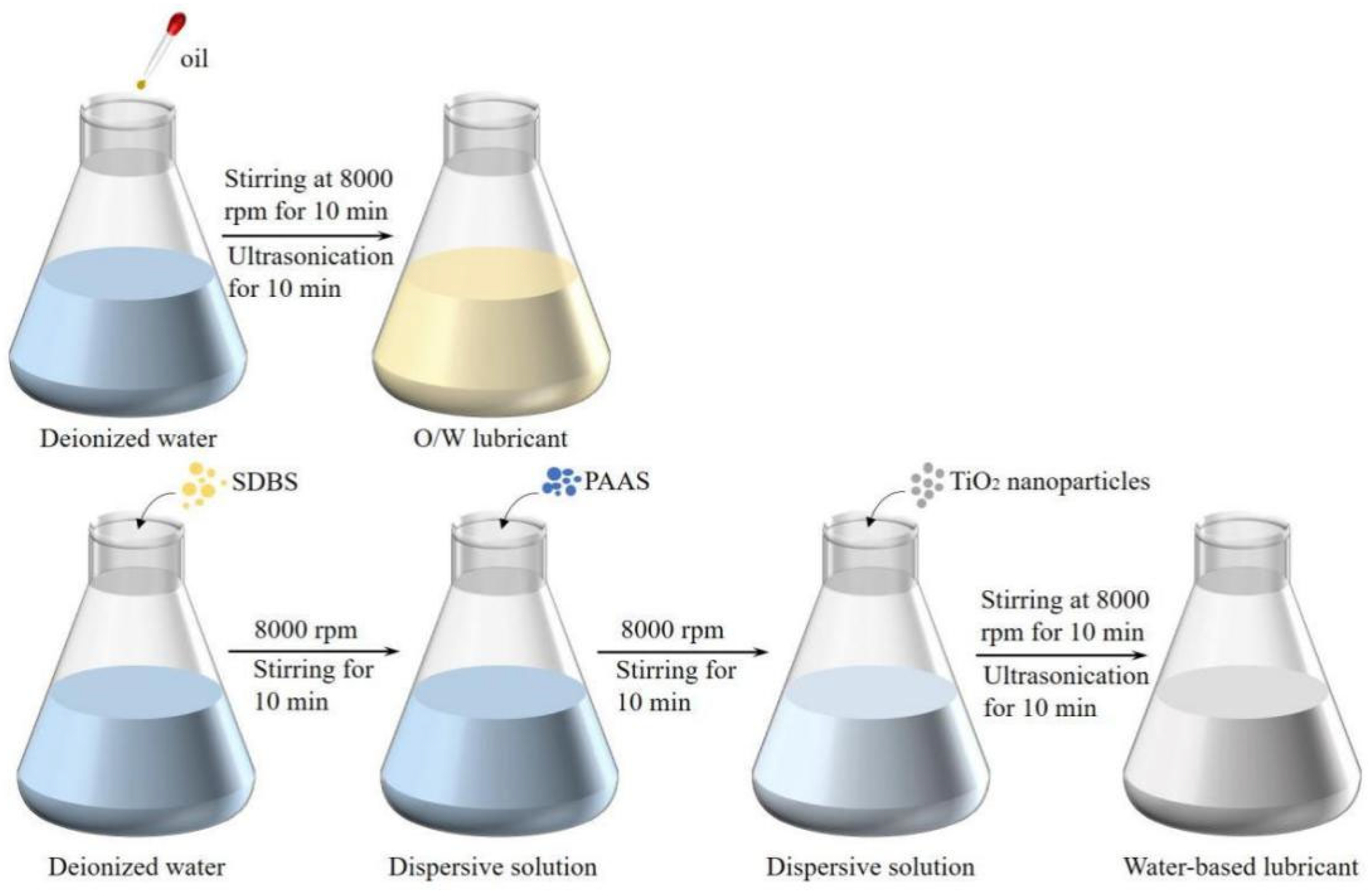
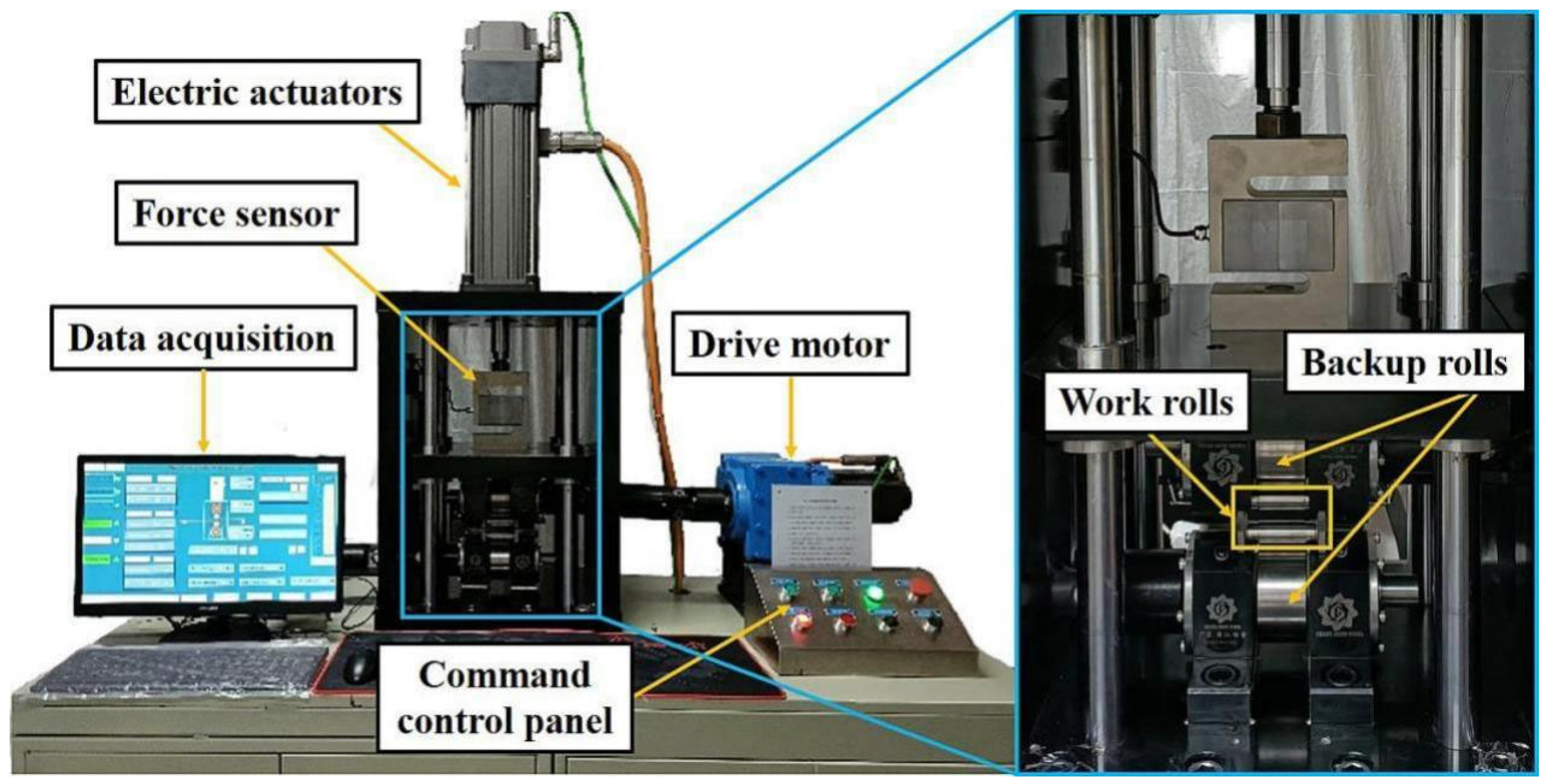
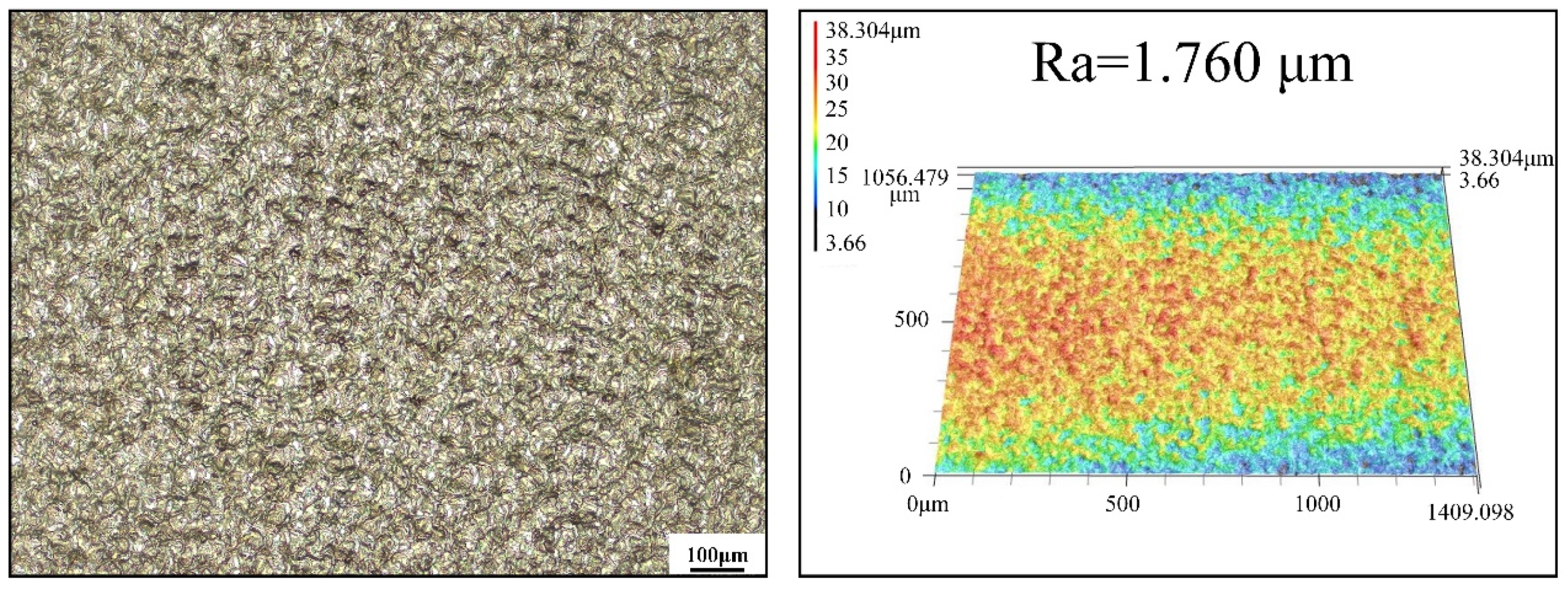
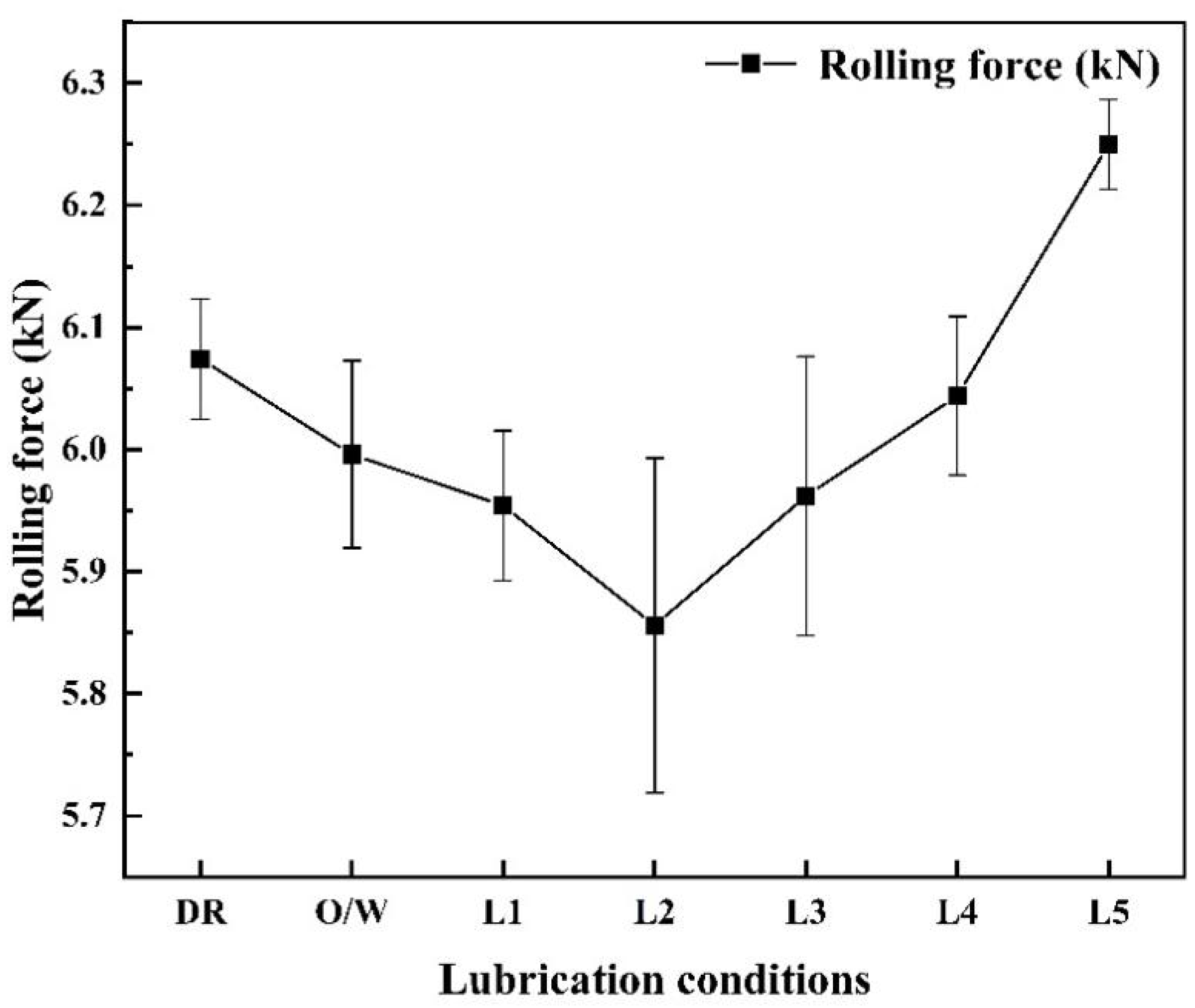

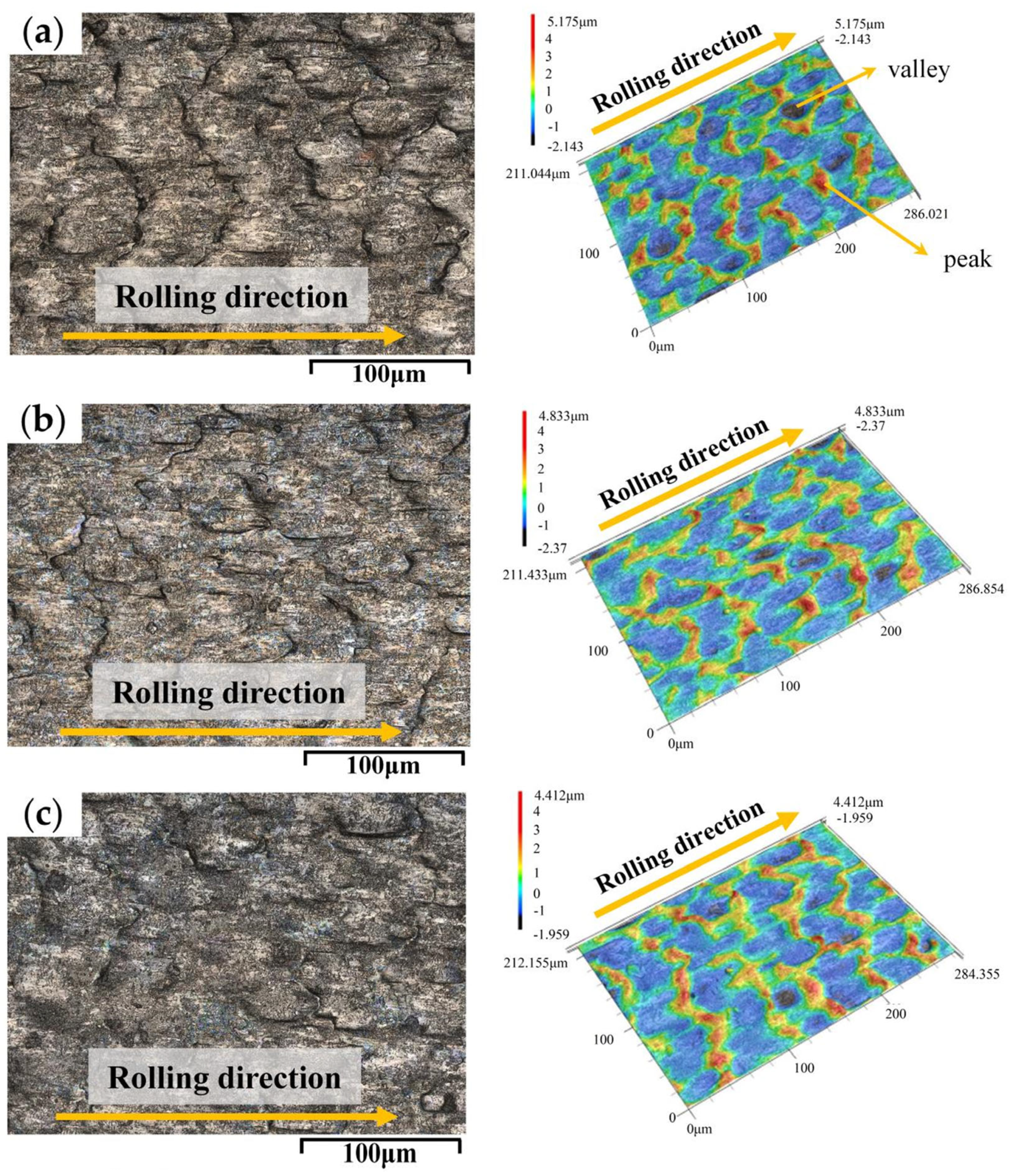
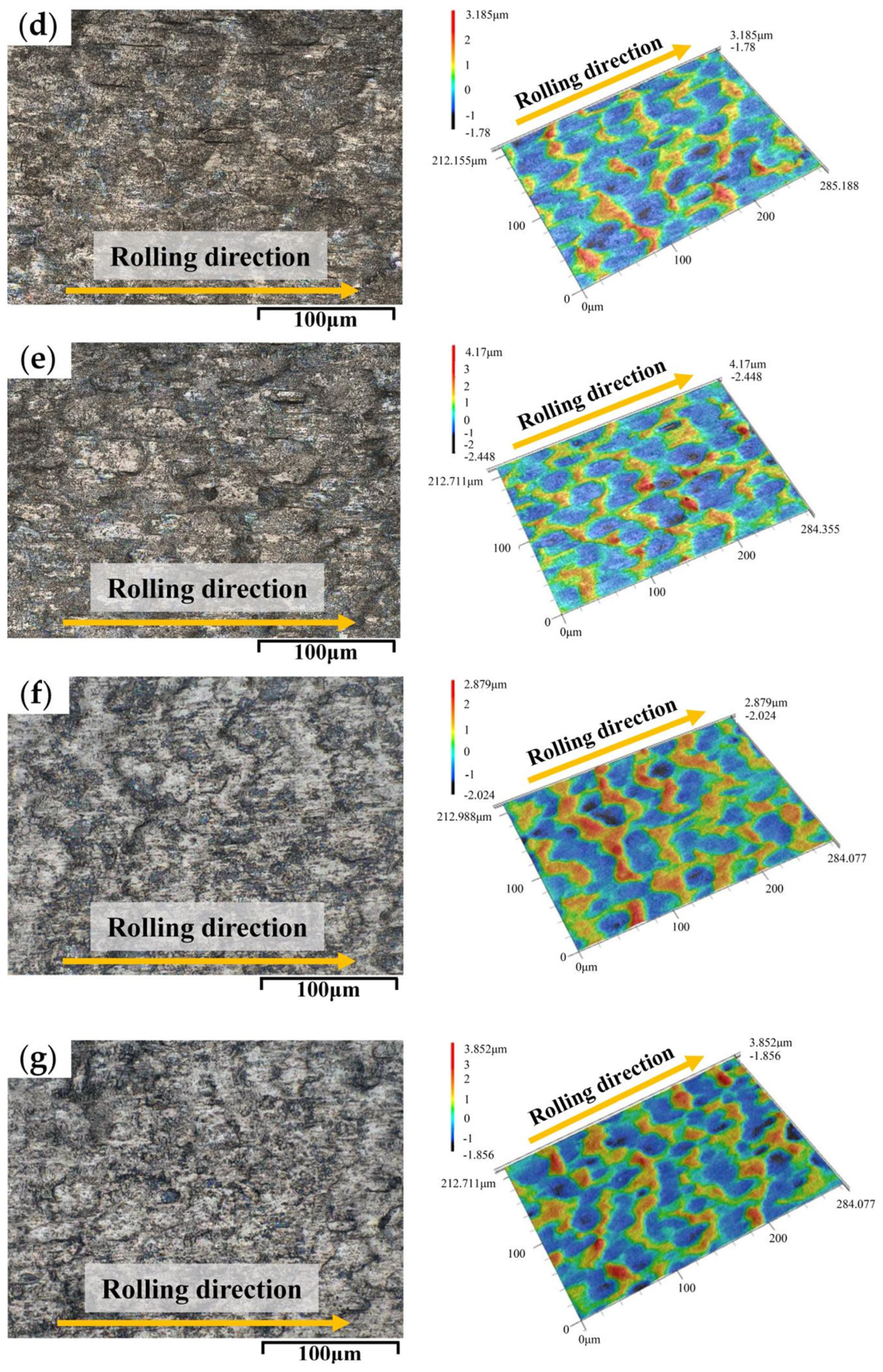
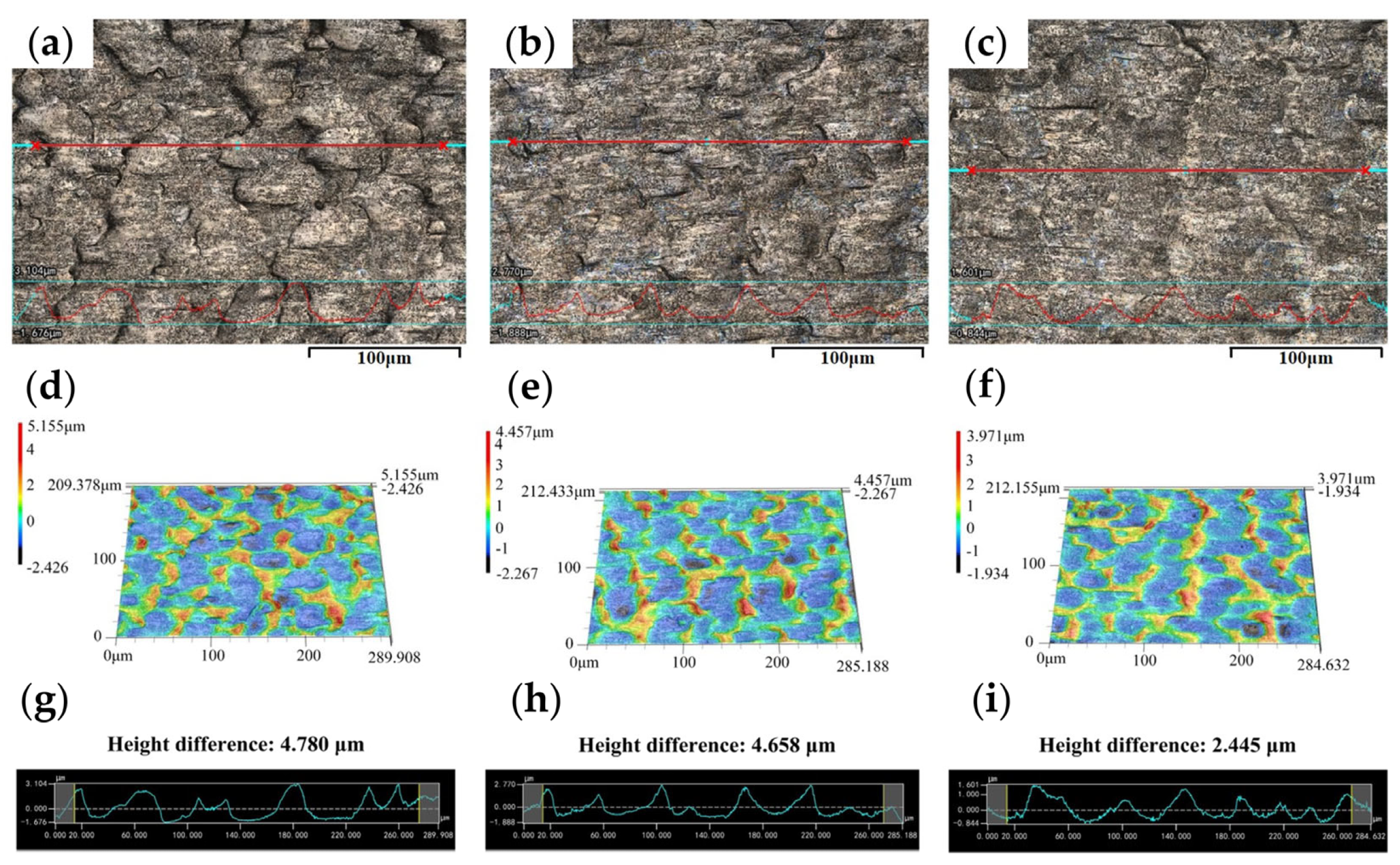

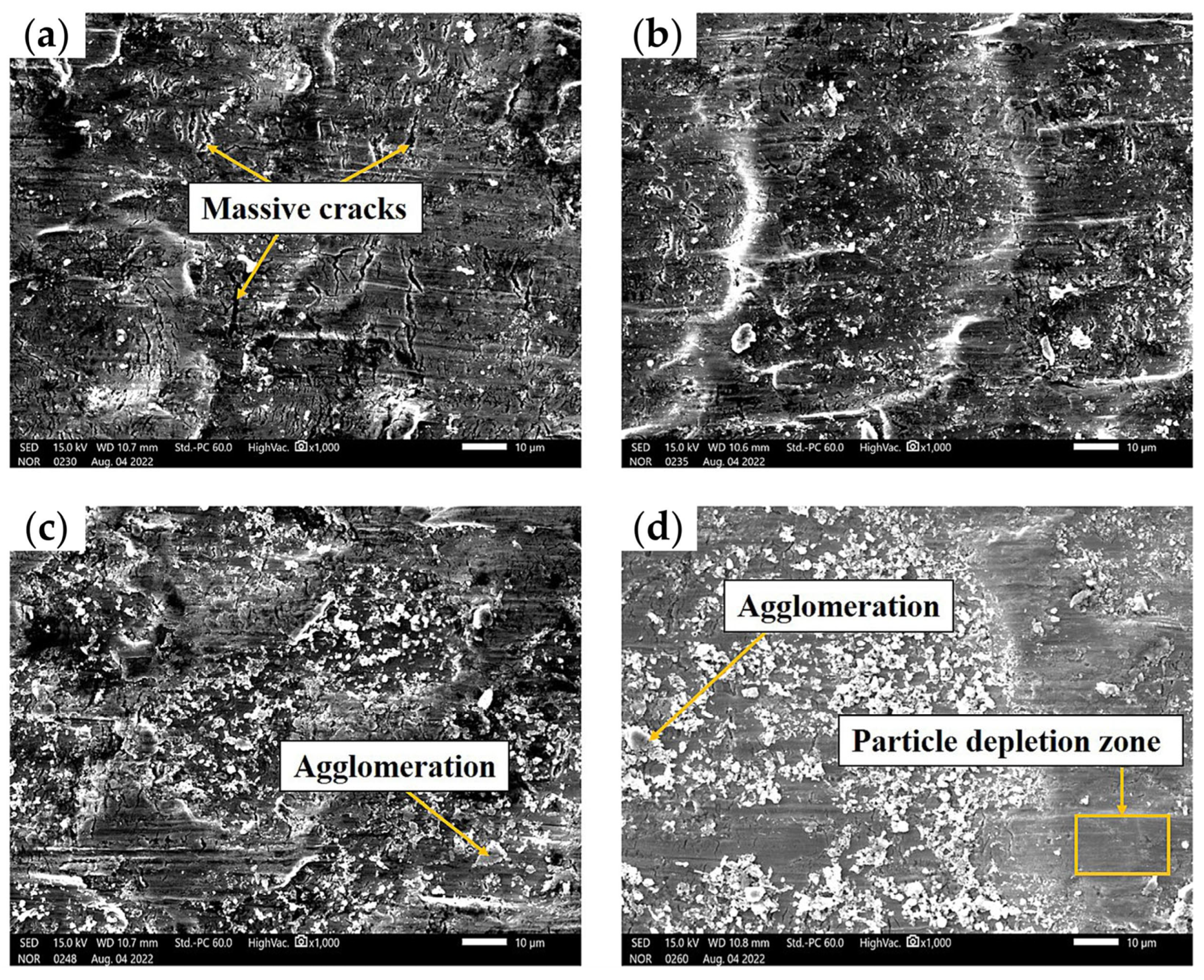
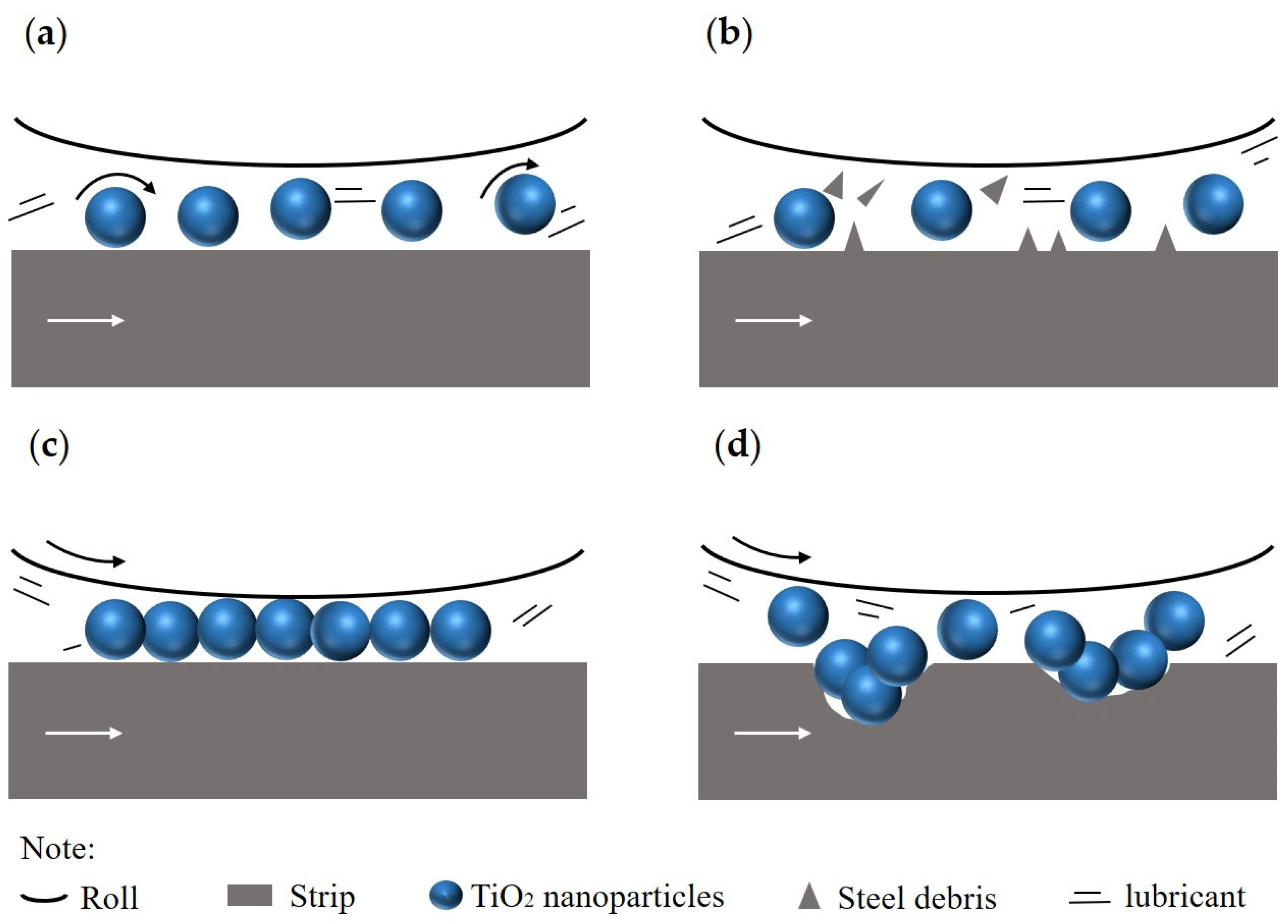

| Element | Ti | Fe | N | H | O | C |
|---|---|---|---|---|---|---|
| Content | ≥99.6 | ≤0.014 | ≤0.008 | ≤0.0013 | ≤0.046 | ≤0.010 |
| Lubricant Conditions | Description |
|---|---|
| DR | Dry |
| O/W | 1.0 wt.% oil + balance water |
| L1 | 1.0 wt.% TiO2 + 0.2 wt.% SDBS + 0.3 wt.% PAAS + balance water |
| L2 | 3.0 wt.% TiO2 + 0.6 wt.% SDBS + 0.3 wt.% PAAS + balance water |
| L3 | 5.0 wt.% TiO2 + 1.0 wt.% SDBS + 0.3 wt.% PAAS + balance water |
| L4 | 7.0 wt.% TiO2 + 1.4 wt.% SDBS + 0.3 wt.% PAAS + balance water |
| L5 | 9.0 wt.% TiO2 + 1.8 wt.% SDBS + 0.3 wt.% PAAS + balance water |
Disclaimer/Publisher’s Note: The statements, opinions and data contained in all publications are solely those of the individual author(s) and contributor(s) and not of MDPI and/or the editor(s). MDPI and/or the editor(s) disclaim responsibility for any injury to people or property resulting from any ideas, methods, instructions or products referred to in the content. |
© 2023 by the authors. Licensee MDPI, Basel, Switzerland. This article is an open access article distributed under the terms and conditions of the Creative Commons Attribution (CC BY) license (https://creativecommons.org/licenses/by/4.0/).
Share and Cite
Ma, L.; Ma, L.; Ma, X.; Zhou, C.; Jiang, Z.; Zhao, J. Tribological Properties and Lubrication Mechanisms of Water-Based Nanolubricants Containing TiO2 Nanoparticles during Micro Rolling of Titanium Foils. Materials 2024, 17, 170. https://doi.org/10.3390/ma17010170
Ma L, Ma L, Ma X, Zhou C, Jiang Z, Zhao J. Tribological Properties and Lubrication Mechanisms of Water-Based Nanolubricants Containing TiO2 Nanoparticles during Micro Rolling of Titanium Foils. Materials. 2024; 17(1):170. https://doi.org/10.3390/ma17010170
Chicago/Turabian StyleMa, Linan, Luhu Ma, Xiaoguang Ma, Cunlong Zhou, Zhengyi Jiang, and Jingwei Zhao. 2024. "Tribological Properties and Lubrication Mechanisms of Water-Based Nanolubricants Containing TiO2 Nanoparticles during Micro Rolling of Titanium Foils" Materials 17, no. 1: 170. https://doi.org/10.3390/ma17010170
APA StyleMa, L., Ma, L., Ma, X., Zhou, C., Jiang, Z., & Zhao, J. (2024). Tribological Properties and Lubrication Mechanisms of Water-Based Nanolubricants Containing TiO2 Nanoparticles during Micro Rolling of Titanium Foils. Materials, 17(1), 170. https://doi.org/10.3390/ma17010170







